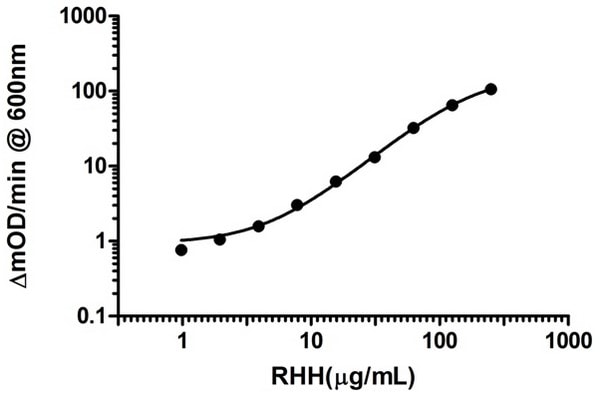Complex I Rodent Profiling ELISA Kit (ab136809)
Key features and details
- Sensitivity: 0.4 µg/ml
- Range: 4 µg/ml - 500 µg/ml
- Sample type: Tissue Extracts
- Detection method: Colorimetric
- Assay type: Sandwich (qualitative)
- Reacts with: Mouse, Rat, Human
Overview
-
Product name
Complex I Rodent Profiling ELISA Kit
See all Complex I kits -
Detection method
Colorimetric -
Precision
Intra-assay Sample n Mean SD CV% Rat heart 8 2% Inter-assay Sample n Mean SD CV% Rat heart 3 6.14% -
Sample type
Tissue Extracts -
Assay type
Sandwich (qualitative) -
Sensitivity
= 0.4 µg/ml -
Range
4 µg/ml - 500 µg/ml -
Assay duration
Multiple steps standard assay -
Species reactivity
Reacts with: Mouse, Rat, Human -
Product overview
ab136809 NADH dehydrogenase (Complex I) rodent profiling kit is an in vitro enzyme-linked immunosorbent assay (ELISA) for the comparison of NADH dehydrogenase levels or profile in tissue lysates. The assay employs an NADH dehydrogenase specific antibody coated onto microplate well plate strips. Samples are pipetted into the wells and NADH dehydrogenase present in the sample is bound to the wells by the immobilized antibody. The wells are washed and a biotin labeled anti-NADH dehydrogenase detector antibody is added. After washing away unbound detector antibody, biotin affinity HRP conjugated streptavidin is pipetted into the wells. The wells are again washed, an HRP substrate solution (TMB) is added to the wells and color develops in proportion to the amount of NADH dehydrogenase (Complex I) bound. The developing blue color is measured at 600 nm. Optionally the reaction can be stopped by adding hydrochloric acid which changes the color from blue to yellow and the intensity can be measured at 450 nm.
Get results in 90 minutes with Human NADH dehydrogenase ELISA Kit (Complex I) (ab178011) from our SimpleStep ELISA® range.
-
Notes
NADH dehydrogenase (Complex I) is the first enzyme of the oxidative phosphorylation (OXPHOS) system within the mitochondrial inner membrane. NADH dehydrogenase is a large protein complex of 950,000 MW made up of 45-46 different subunits. Seven of the subunits of the complex are encoded on mitochondrial DNA (mtDNA), the remaining subunits are nuclear encoded, made in the cytosol and translocated into the organelle for assembly at the inner membrane. The enzyme complex catalyses electron entry from NADH via a flavin (FMN) and several non-heme iron centers. Mutations in mtDNA, or nuclear DNA genes encoding NADH dehydrogenase subunits or assembly factors are a common cause of genetic OXPHOS defects. Mutations or loss of mtDNA may cause enzymatic dysfunction by disrupting enzyme assembly or alternatively by specifically affecting enzymatic activity with no effect on enzyme assembly.
-
Platform
Microplate
Properties
-
Storage instructions
Store at +4°C. Please refer to protocols. -
Components 1 x 96 tests 10X Blocking Buffer 1 x 6ml 10X HRP Label 1 x 1ml 10X NADH Dehydrogenase Detector Antibody 1 x 1ml 20X Buffer 1 x 20ml Extraction Buffer (ab260490) 1 x 15ml NADH Dehydrogenase Microplate 1 unit HRP Development Solution 1 x 12ml -
Research areas
-
Alternative names
- NADH dehydrogenase
Images
-
Example of positive control sample standard curve. A dilution series of mouse heart homogenate (MHH) extract in Incubation Buffer in the working range of the assay.
-
Example of positive control sample standard curve. A dilution series of rat heart homogenate (RHH) extract in Incubation Buffer in the working range of the assay.
-
Components requirement and immune assay specificity were determined by skipping one critical component or replacing with unrelated antibodies. The sample was rat heart homogenate (RHH) at the concentration of 500 µg/mL.











